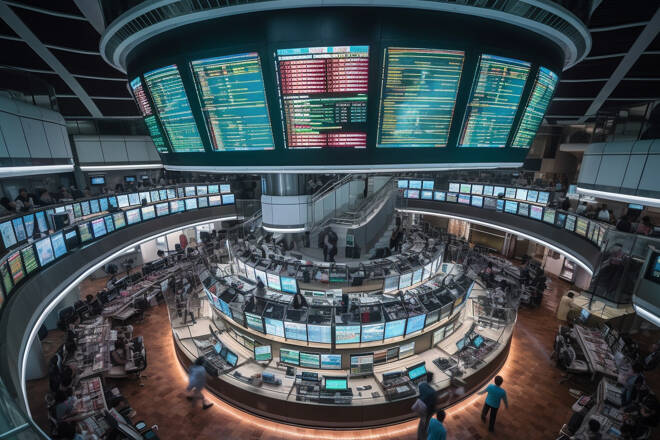Advertisement
Advertisement
Hang Seng Index, ASX 200, Nikkei 225 Index: FOMC Projections Set the Stage for Asian Fall
By:
As the FOMC eyes a potential November rate hike, global indexes waver, testing forecasts and investor resolve.
Key Insights:
- Nikkei and Hang Seng’s downward trajectory guided ASX 200 into bearish territory on Wednesday.
- US equity markets’ overnight losses to shape Thursday’s trading sentiment.
- With the US Federal Reserve rate held at 5.50%, eyes now shift to the Bank of Japan.
Overview of the Wednesday Session
On Wednesday, the Nikkei and Hang Seng Index led the ASX 200 into negative territory. Rising government bond yields reflected the market fear of a hawkish Fed interest rate trajectory.
Trade data from Japan added to the gloomy mood. In August, the Japanese trade deficit widened from ¥66.3 billion to ¥930.5 billion. Economists forecast a deficit of ¥659.1 billion. However, it would have been unlikely that a trade surplus would have offered relief in the run-up to the Fed interest rate decision.
The People’s Bank of China failed to provide comfort despite leaving loan prime rates unchanged.
Overnight losses across the US equity markets set the tone for the session. The recent upswing in crude oil prices has reignited fears of sticky inflation, which could force central banks to leave interest rate hikes on the table.
On Tuesday, the S&P 500 and NASDAQ Composite Index saw losses of 0.22% and 0.23%, respectively, with the Dow falling by 0.31%.
The Overnight Fed Interest Rate Decision to Dictate Risk Appetite
On Wednesday, the US Federal Reserve left interest rates at 5.50%, aligned with market expectations. However, FOMC Economic Projections and Fed Chair Powell press conference will influence investor sentiment on Thursday.
With no economic indicators from the Asian region for investors to consider, the markets will have no distraction.
The projections leave a November rate hike on the table and push back the timing of a first Fed interest rate cut. 10 of 19 FOMC members project rates to hold above 5% throughout 2024. Investors previously expected the Fed to bring interest rates down sharply in 2024.
The hawkish interest rate trajectory will test buyer appetite ahead of the Bank of Japan monetary policy decision.
Looking at the Futures Markets, the ASX 200 was down 22 points, with the Nikkei falling by 140 points. The NASDAQ Composite Index slid by 1.43% on Wednesday, with the Dow and S&P 500 seeing losses of 0.22% and 0.94%, respectively.
ASX 200
The ASX 200 fell by 0.46% on Wednesday. Tech stocks struggled for the third consecutive day. The S&P/ASX All Technology Index (XTX) ended the day down 0.13%. However, mining saw heavier losses.
BHP Group Ltd (BHP) and Rio Tinto (RIO) ended the day down 1.02% and 1.27%, respectively. Fortescue Metals Group (FMG) slid by 1.72%, while Newcrest Mining (NCM) bucked the trend, rising by 0.38%.
The big four banks had a mixed session. The National Australia Bank (NAB) and ANZ Group (ANZ) gained 0.03% and 0.12%, respectively. However, the Commonwealth Bank of Australia (CBA) and Westpac Banking Corp (WBC) fell by 0.28% and 0.74%, respectively.
Oil stocks stumbled. Woodside Energy Group (WDS) and Santos Ltd (STO) saw losses of 2.12% and 1.91%, respectively.
Hang Seng Index
The Hang Seng Index ended the Wednesday session down 0.62%.
Alibaba Group Holding Ltd (9988.HK) and Tencent Holdings Ltd (0700.HK) saw losses of 0.35% and 1.02%, respectively.
Bank stocks had another mixed session. China Construction Bank (0939.HK) fell by 0.52%. However, the Industrial and Commercial Bank of China (1398.HK) and HSBC Holdings PLC (0005.HK) gained 0.23% and 0.66%, respectively.
Nikkei 225
(Graph for reference purposes only)
The Nikkei 225 ended the day down 0.66%.
Sumitomo Mitsui Financial Group (8316) gained 0.28%, while Mitsubishi UFJ Financial Group declined by 1.77%.
However, the main components had a mixed session.
Sony Corp. (6758) fell by 1.60%, with SoftBank Group Corp. (9984) declining by 0.54%.
Tokyo Electron Limited (8035) and Fast Retailing Co (9983) ended the day with losses of 0.12%. KDDI Corp. (9433) bucked the trend, gaining 0.21%.
For upcoming economic events, check out our economic calendar.
About the Author
Bob Masonauthor
With over 28 years of experience in the financial industry, Bob has worked with various global rating agencies and multinational banks. Currently he is covering currencies, commodities, alternative asset classes and global equities, focusing mostly on European and Asian markets.
Did you find this article useful?
Latest news and analysis
Advertisement
